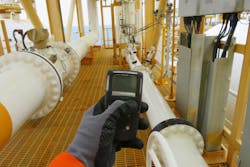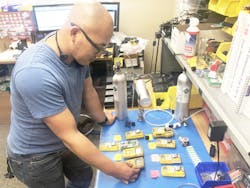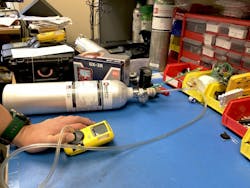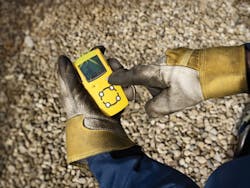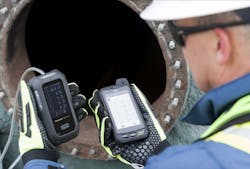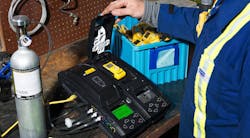Gas detection techniques have a fascinating history, dating back to the 19th century when canaries served as early warning systems for toxic gases in coal mines. When coal emerged as the Industrial Revolution’s energy source of choice, miners began using flame safety lamps to detect dangerous atmospheric changes in their work environments. Over time, these rudimentary methods gave way to catalytic sensors, which offered more reliable detection of hazardous gases.
Today, modern detection systems employ cutting-edge technologies (e.g., infrared and electrochemical sensors) to help maintain safe working environments in essential industries, such as semiconductor manufacturing, oil and gas, and wastewater treatment. The critical role that gas detectors play in worker safety across industries has led to a market valued at $1.85 billion, with an expected annual growth of 5% between 2024 and 2032.
However, even the most advanced gas monitoring solutions can encounter issues over time. As such, knowing how to troubleshoot common gas detector issues is essential if you and your team regularly work in environments with potentially hazardous atmospheres. Below, we explore four of the most common gas detector problems and offer practical tips for resolving them.
1. Gas Detector Won’t Turn on
While there are several potential causes for this, they’re often tied to different variables surrounding the device's power source.
Troubleshooting Steps:
-
Check the battery: Try replacing the batteries or recharging the unit. If replacing the batteries or recharging the device doesn’t solve the issue, check the battery compartment for acid leaks, corrosion or damage. You can also consult the user manual and check the operating temperature range, as low temperatures can interfere with the voltage of alkaline batteries.
-
Inspect power contacts: Over time, dust, debris or corrosion can accumulate on the battery contacts or the power cable connector. Gently remove any buildup using a clean, dry cloth. For fixed gas detectors, start by inspecting the power cable for any visible damage. If everything looks intact, test the voltage going into the device. If there’s no voltage, inspect the fuse connectors running in and out of the marshalling cabinet and check the wiring inside the terminal block. The wires could be loose or in the wrong configuration.
-
Software and firmware updates: Sometimes, a bug in the existing software could prevent the device from powering up. Newer firmware versions often improve compatibility with different power sources, batteries or communication protocols. Ensuring your device has the latest firmware can resolve power-related glitches.
If the gas detector still doesn't turn on after following these steps, contact the manufacturer's customer support. The device may require servicing or parts replacement.
2. Gas Detector Won’t Calibrate
Calibration is essential to ensuring that a gas detector provides accurate readings. When the device refuses to calibrate, it can compromise worker safety by creating a false sense of security.
Gas detector sensors have a service life and are generally not fail-safe. For instance, a lower explosive limit (LEL) sensor may show a lower reading of explosive gases as it ages. Without observing a proper calibration schedule, this may go unnoticed until significant safety issues occur.
Troubleshooting Steps:
-
Expired sensors: Gas detector sensors typically have a service life of two to three years. Over time, they degrade and lose their ability to detect gases accurately. If your device won’t calibrate, one of the first things to check is whether the sensors need replacing.
-
Incorrect calibration gas: Make sure you’re using the appropriate calibration gas for the specific gas detector sensor, as the incorrect gas types and concentrations can lead to calibration failure. Check the test gas expiration and refer to the manufacturer's guidelines for detailed calibration instructions. Keep in mind that calibration gases typically expire within three years, depending on whether they're reactive or nonreactive.
-
Environmental conditions: Sometimes, external environmental conditions (e.g., high humidity or extreme temperatures) can interfere with calibration. Ensure you’re calibrating in a controlled environment in accordance with the manufacturer’s recommendations.
Low battery levels can also interfere with the calibration procedures. Ensure the device has a sufficient charge before attempting to calibrate. We recommend bump testing before each use (more on that, below) and calibrating at least every six months.
3. Sensor Error and Replacement
The lifespan of gas detector sensors varies depending on the sensor type, usage and the environment in which they operate. As sensors age, they lose their sensitivity and may produce false readings or error codes.
Troubleshooting Steps:
-
Sensor lifespan: Check the user manual to determine the individual sensor's expected lifespan. Replacing the sensors may resolve the issue if they are approaching or beyond their recommended service life.
-
Identify the error code: Most gas detectors display error codes when a sensor malfunctions. The user manual provides a list of error codes and the corresponding troubleshooting advice.
-
Sensor maintenance: Dirt and grime can collect around the sensor housing. Use a brush or compressed air to clean the sensor filter and remove any debris that could interfere with the signal. Use a nonabrasive cloth or tool to clean the area around the sensor.
-
Cross-interference: Electromagnetic interference (EMI) from radio frequencies (e.g., cell towers, communication networks and radio transmitters) can interact with gas detector sensors. This can result in unintended responses, including false alarms or exaggerated readings.
When replacing sensors, let it stabilize in ambient air before calibration. The stabilization time can vary depending on the detector model, but it typically ranges from 30 minutes to three hours. Stabilization allows the sensors to settle and reach equilibrium, helping ensure accurate baseline measurements.
4. Cross-Sensitivity Issues
Cross-sensitivity occurs when a sensor designed to detect a specific gas reacts to other non-target gases. This can lead to false positive or negative readings, triggering unnecessary alarms.
Troubleshooting Steps:
-
Use filtered sensors: Some gas detectors have sensors with filters designed to reduce cross-sensitivity by blocking non-target gases from interfering with the readings. If you frequently experience cross-sensitivity, consider upgrading to sensors with this feature.
-
Regular calibration: Regularly calibrating the gas detector can minimize the impact of cross-sensitivity, as this helps the device adjust to changing environmental factors to maintain its accuracy. The optimal calibration frequency will depend on the manufacturer's recommendations, the types of gases monitored and the working environment.
-
Maintain proper ventilation: Ensuring adequate ventilation in the workspace helps reduce the concentration of interfering gases and minimize the likelihood of cross-sensitivity in gas detectors. Proper airflow can disperse non-target gases, leading to more accurate readings. Consider using portable ventilation systems, especially in confined spaces or poorly ventilated areas, to help maintain air quality and reduce the risk of sensor interference.
Every manufacturer publishes a cross-sensitivity chart outlining how non-target gases can affect the readings on different types of gas sensors. Post this resource in the workplace or give every worker a copy they can carry with them.
The Importance of Maintenance
Despite the robust construction of modern gas detectors, the sensors they use are relatively delicate and require regular testing, calibration and proper maintenance. Here are a few best practices to help optimize the service life of your gas monitoring solutions:
-
Routine sensor testing: Sensors should be tested regularly to ensure they are working properly. The easiest way to do this is through bump testing, which briefly exposes the sensor to a small amount of gas to verify its response. Many gas detection systems have optional docking stations that automatically perform, record and remind users about bump tests and calibration.
-
Document maintenance: Keep detailed records of all maintenance, bump testing and calibrations performed on each gas detector. We recommend using gas detectors with data-logging capabilities that can automatically store this data, including concentration levels, alarm events and testing history. This information can help identify recurring issues and ensure the device complies with safety standards.
- Proper storage: Store gas detectors in a dry, controlled environment to prevent damage to sensitive sensors. Avoid areas with high moisture levels, dust or extreme temperatures, as these can contribute to sensor degradation.
While gas detectors are designed to be robust and reliable, they can malfunction due to various environmental and usage factors. Ensuring gas detectors are in good working condition is crucial before beginning any work. Workers must make it a habit to check their gas detector equipment before every use, just as they do with any other safety gear.
Beyond providing the appropriate safety equipment, safety teams should also take the initiative of creating training programs and reference materials to ensure workers understand how to maintain and troubleshoot their gas detection equipment. By training workers on basic troubleshooting and observing proper maintenance practices, you can help ensure your team gets the protection they deserve.
The concept of the connected worker has been an evolving aspect of the gas detector market. Some early innovations have been focused on closed or proprietary manufacturer’s systems. Now, we are seeing a trend toward using third-party apps to connect gas detectors wirelessly to cloud-based systems. Making the connection much less expensive makes the tools and technology available to a broader range of customers. This should, in turn, drive further innovation.
By giving managers both real-time insights as well as information and data recording, they are in a better position to troubleshoot early and perform proactive maintenance to ensure that all equipment is in good working order–and that workers know how to properly use gas detectors. This will allow more workers to do their jobs safely and return to their families at the end of their shifts.
About the Author

Rick Pedley
Rick Pedley is president and CEO of PK Safety, a supplier of occupational safety and personal protective equipment since 1947.
